The last decade has witnessed ecotourism gain traction in India. The country’s diversity with plenty of ecotourism destinations has made this happen. Although it is still a relatively new type of travel, India has already earned its spot as one of the best places for ecotourism globally. The government has taken various steps to promote the importance of ecotourism too. If you love travelling, there are ample ecotourism opportunities in India.
Ecotourism has both advantages and disadvantages. Especially when people are looking for a break from pollution-filled urban environments, nature tourism has become a popular solution. India has no dearth of natural forests, biological parks, and wildlife sanctuaries. A growing number of people now seek to explore such places and spend more time in nature. Indeed, going on an ecotourism trip is a great way to spend a vacation and enjoy your time away from the bustle of the city.
However, there is more to ecotourism than visiting places known for their natural beauty. This is a form of sustainable tourism that helps promote the culture and livelihood of the locals and the natives. Moreover, the best practices for ecotourism that I am going to explain, aren’t destructive or invasive towards the environment.
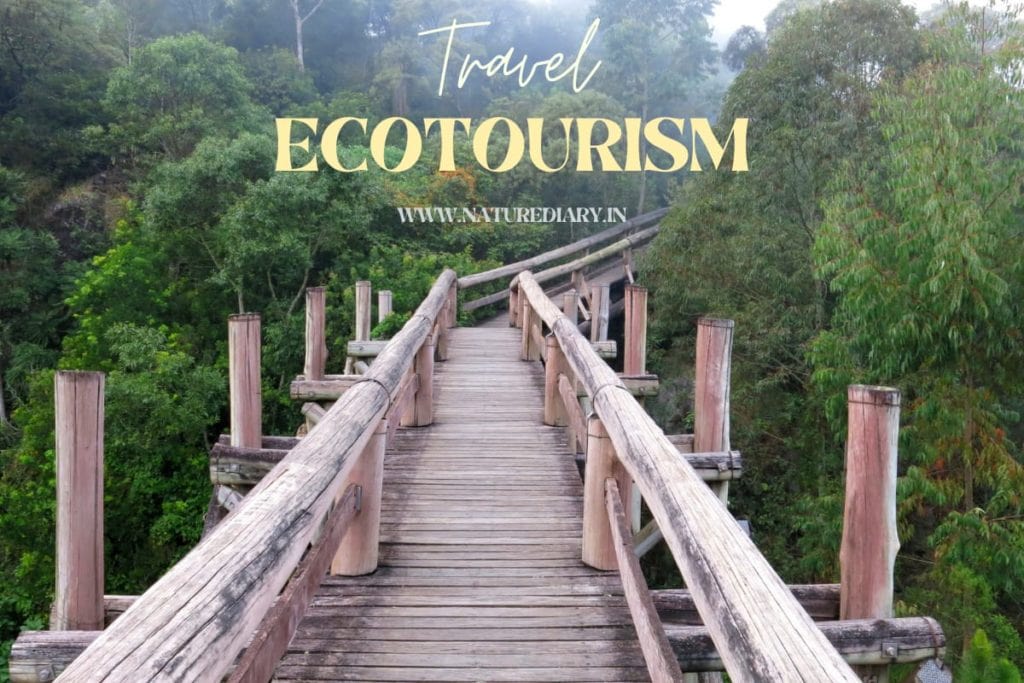
What Is Ecotourism?
Ecotourism refers to a sustainable form of tourism where people primarily visit places rich in natural resources, such as mountains and wildlife sanctuaries. It may involve a variety of fun and eco-friendly activities like hiking, cycling, trekking, birdwatching, camping, etc. Village homestays are a great way to enjoy accommodation in peaceful and serene places while supporting local businesses.
One of the most notable aspects of sustainable ecotourism is its focus on preserving the environment and natural resources. After all, this tourism segment is based completely on natural resources as the key attraction for tourists. Poor practices that lead to the destruction of these resources will harm the tourism industry itself, besides destroying the environment. Tourists visiting such places are expected to be responsible and follow eco-friendly practices.
Importance Of Ecotourism
There are reasons why the government supports the growth of ecotourism in India. Of course, the abundance of ecotourism destinations is a major factor. However, ecotourism is also important to the economy, tourism industry, environment, and local communities. The following points should explain the importance of ecotourism-
The tourism sector is certainly one of the notable contributors to India’s economy, bringing in plenty of revenues. However, ecotourism stands out particularly due to its benefits to local economies. Homestays, restaurants, and shops run by natives and locals generate revenues, which aids them with their livelihood and helps such regions flourish.
In addition to helping spread awareness, sustainable tourism also has direct benefits for the environment. Using natural resources to generate revenues from ecotourism helps protect them from destruction. Moreover, ecotourism widely endorses green modes of transport and other eco-friendly practices.
Ecotourism helps to spread awareness regarding the environment and natural resources. Hearing and reading about beautiful forests is one thing, but visiting them in person is far more effective in growing an urge to help conserve them. As people come across various endangered species and learn about them, they are more likely to embrace eco-friendly practices.
Many ecotourism destinations lie in rural regions inhabited by various indigenous communities. Visiting such places and spending time with such communities helps people learn about their culture, way of life, and struggles. This promotes greater understanding, tolerance, and kindness between different races and cultures.
Connectivity features, transport, and infrastructure are crucial in attracting tourists. There are plenty of examples of development projects being undertaken in poorly developed regions to promote ecotourism. This helps such regions grow sustainably while preserving the local resources too. This, in turn, ensures a better life for the locals.
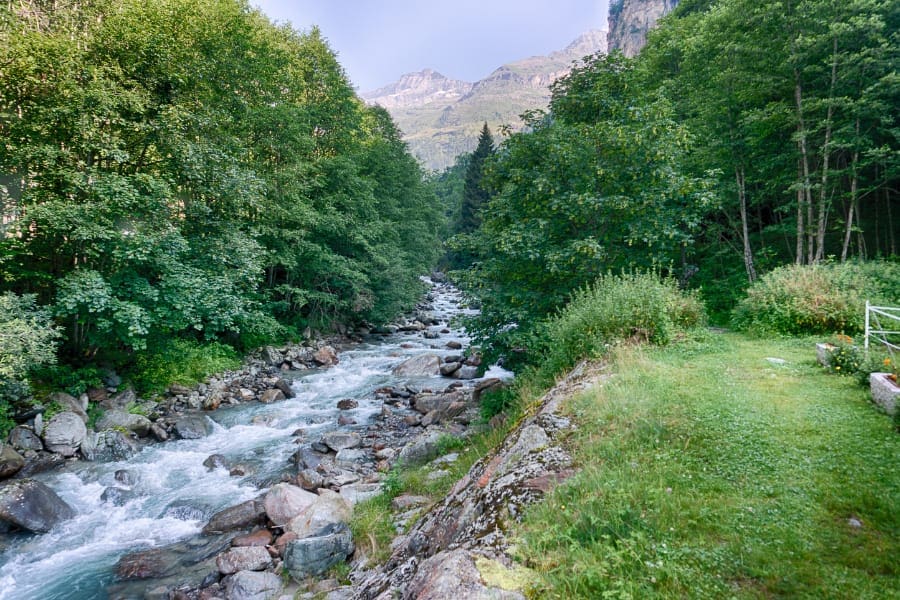
Advantages Of Ecotourism
Ecotourism comes with an array of benefits, which is reflected in its increasing popularity. The most notable among these are-
Firstly, the key reason why an increasing number of people are opting for nature travel is that it offers a beautiful experience. Different ecosystems come with unique flora and fauna exclusive to those places. Moreover, spending time surrounded by natural beauty is simply a great way to spend your holidays. Certain ecotourism activities like hiking, trekking and camping are also very adventurous and exciting, guaranteeing great memories.
Ecotourism also comes with great learning experiences for tourists of every age. Exploring various locations and communities comes with a treasure trove of knowledge about the world. You’d learn first-hand about people from various ethnic groups and the customs they follow. The practical knowledge gained through nature tourism is also extremely helpful for students or professionals specializing in certain subjects, such as zoology, botany, etc.
Visiting and spending time in places surrounded by nature is also great for your health. Especially for individuals residing in cities, visiting ecotourism destinations full of lush greenery is beneficial. Not only does it offer a refreshing and serene environment for a change, but the clean and unpolluted air helps the body relax and rejuvenate. Visiting a wildlife sanctuary or a mountain is far healthier than visiting an urban place.
One of the best things about sustainable ecotourism is the diverse range of options for every individual. After all, India is one of the best countries in the world in terms of biodiversity, with plenty of ecotourism destinations. Besides catering to individuals with different tastes, such a diverse variety of destinations also ensures great travelling experiences for different budgets. Whether you want a quick, affordable trip or a long homestay, you can likely find something suitable.
Are you looking for a way to help people live a sustainable life? Well, you contribute to the creation of employment through ecotourism. As tourism grows, so do the opportunities for locals to launch eateries and other small businesses. In India, the cottage industry deserves special mention. Many locals residing in popular ecotourism destinations make a living by selling handicrafts.
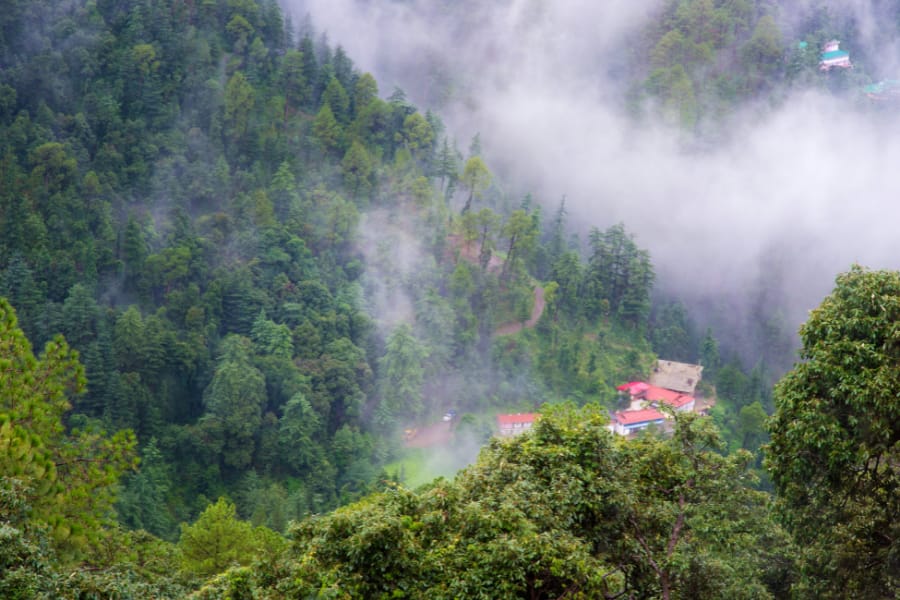
Disadvantages Of Ecotourism
Clearly, ecotourism has amazing benefits for the tourists, the locals, and even the natural flora and fauna. However, there are also certain drawbacks of ecotourism, such as-
As ecotourism involves enjoying nature in its pristine form, such locations often lack adequate infrastructure. This can make certain places hard to access, especially in poor weather conditions. For instance, some places have limited public transport or lack modern roads. Before going on an ecotourism trip, always make sure to research the available connectivity features beforehand.
One of the key differences between regular tourism and ecotourism is that the latter allows you to stay relatively closer to nature. Hence, if you are generally accustomed to luxurious travelling experiences, you’d have to adapt to staying at homestays or camping in tents. While high-end hotels and other facilities are now available at many ecotourism destinations, it is still advisable to opt for accommodation and transport that offers a more natural experience.
Greenwashing is malpractice where some tour operators do not follow environment-friendly practices, although they claim to do so. Hence, if the supposed eco-friendly advantages of sustainable tourism are a reason why you chose such a trip in the first place, this would beat the purpose. It is good to ask detailed questions before you hire a tour operator if greenwashing concerns you.
While the primary goal of ecotourism is to promote the sustainable development of local communities, it often ends up displacing them instead. Natives of the most marketable ecotourism may potentially be relocated to make space for accommodations for the expansion of other tourism infrastructure. Besides, the locals may also dilute their own culture to cater to tourists.
In case a region with a fragile ecosystem turns into a popular tourist attraction, it can lead to excessive pressure on the area’s natural resources. This can cause an imbalance in the environment and deplete the resources dispute measures taken to promote sustainable tourism. Overcrowding is a major issue too and can affect wildlife negatively.

Best Ecotourism Destinations In India
Rich in biodiversity, India is home to numerous ecotourism destinations. Especially in recent times, active efforts by the authorities have led to the development of several new places for ecotourism. With that said, let us take a look at the examples of some of the best destinations for ecotourism in India-
1. Odisha Ecotourism Nature Camps
When it comes to the best places for ecotourism in India, Odisha is undoubtedly a great choice. This state includes 37 nature camps at Bhitarkanika, Satkosia, Simlipal, Chilika, Bichitrapur, Chandipur, Koraput, and other places. Odisha ecotourism also offers jungle safari at Chandaka Wildlife Sanctuary, Debrigarh Wildlife Sanctuary, Similipal Wildlife Sanctuary, etc.

According to Odisha Forest Development Corporation (OFDC), Odisha houses 110 species of reptiles, 20 species of amphibians, 479 species of birds, and 86 species of mammals, including elephants, tigers, leopards, sambar, spotted deer, wild boar, giant squirrel, crocodile, and many migratory birds. So, if you are a wildlife enthusiast or love birdwatching, these nature camps and sanctuaries would be the ideal ecotourism destinations for you.
The Govt. of Odisha has worked pretty well towards promoting ecotourism on a large scale. All of the nature camps mentioned above have luxury accommodations, good quality foods, and attractions for boating, birdwatching, trekking, hiking, camping, stargazing, photography, etc. Blue Flag Golden Sea Beach near Puri is another project by the Govt. of Odisha to promote sustainable tourism with eco-friendly practices.
2. Thenmala Ecotourism Project, Kerala
Located in Kerala, Thenmala is the first planned ecotourism destination in India. “Thenmala” translates into “honey hill” in the local language as high-quality honey is exported from this area. The World Tourism Organization has selected Thenmala as one of the premier eco-friendly projects in the world.
Thenmala consists of ten notable tourist spots, including hill ranges spanning three districts – Thiruvananthapuram, Kollam, and Pathanamthitta. With dense forests, tree plantations, and plenty of rubber trees, Thenmala offers a clean environment rich in lush greenery.
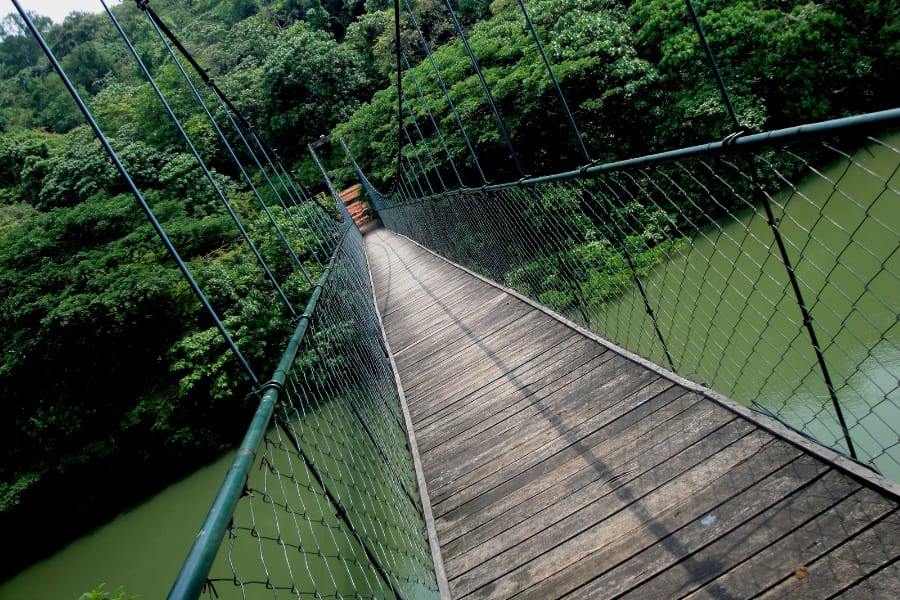
At Thenmala, you can enjoy your time in tree huts built deep in the forests. These huts allow tourists to enjoy the closeness to Mother Nature to the fullest. The region also includes the Shendurney Wildlife Sanctuary, and the boat ride to this sanctuary offers a remarkable experience. You can also enjoy various other activities in Thenmala, including adventurous ones like rock climbing and mountain biking.
Kerala is also home to several other ecotourism attractions that make it one of the best states for tourists to visit. Located on the Western Ghats, next to the Arabian Sea, this tropical region is rich in biodiversity and offers amazing closeness to nature. In fact, National Geographic Traveller has listed Kerala among the places that one should visit at least once in a lifetime.
Kerala presents tourists with ample opportunities to indulge in various sports and other activities. These include boating, mountain biking, rock climbing, and more. Besides the diverse flora and fauna of Thenmala, Kerala is also home to beautiful water bodies. All these attractions make Kerala the perfect destination for nature lovers. Kerala is one of the places where Ayurveda, the ancient healing science of India, flourished.
Besides Thenmala Ecotourism Project, some of Kerala’s best nature tourism spots include Silent Valley National Park, Munnar, Periyar National Park, Gavi, etc. The scenic beauty of the backwaters is something you shouldn’t miss.
3. Dzongu Valley, Sikkim
Sikkim presents a rich cultural heritage home to several tribes and other indigenous communities. The beautiful hills and the diverse forests in Sikkim make it perfect for nature tourism. The state is home to around 200 species of butterflies, more than 2000 species of moths, almost 600 species of birds, 558 species of orchids, 39 Rhododendron species, and more. The Khangchendzonga National Park lies in Sikkim too and is listed by UNESCO as one of the National Heritage Sites in the world.
Among all travel destinations in Sikkim, Dzongu valley- the holy paradise land of 4000 indigenous Lepchas is a remarkable ecotourism destination in India. Located 65 Km away from Gangtok, the capital of Sikkim, it is divided into two regions- Upper Dzongu and Lower Dzongu.
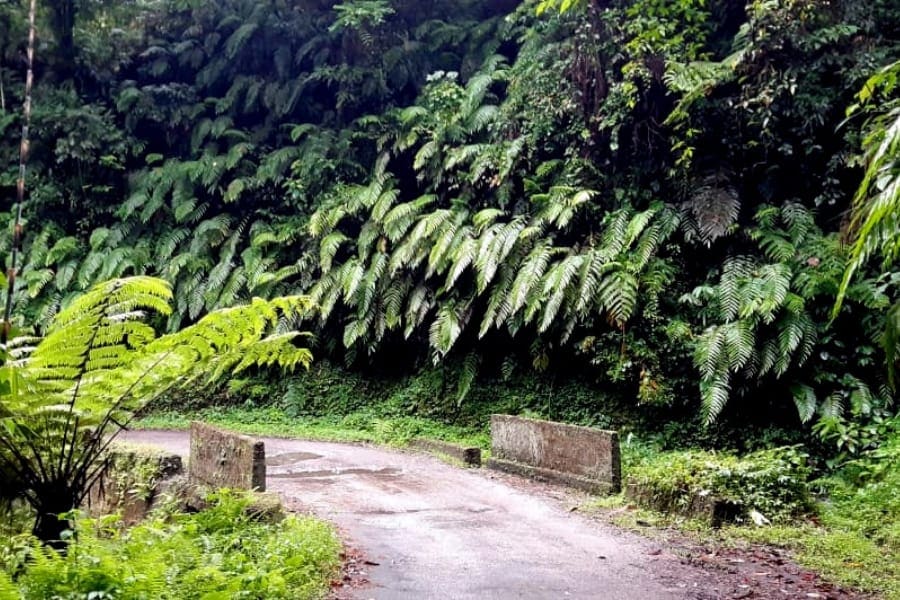
Dzongu covers around 78 sq. Km of an area with an elevation ranging from 700-6000 meters. The landscape is diverse with snowy mountains, and dense forests full of ferns, orchids and rhododendrons, rivers, waterfalls, and whatnot! The Govt. of Sikkim has made it a protected area where you need a tourist permit to enter.
Dzongu in Sikkim is a great eco-tourism destination for you if you love exploring the mountains and culture of the indigenous people. Besides these, there is no shortage of adventure activities like hiking and trekking opportunities in Dzongu valley either.
Sikkim is the first “organic state” in India, and the whole food chain at Dzongu works on organic farming without using pesticides or inorganic nutrient supplements. Besides farming, many locals rely on ecotourism in the peak seasons. Lingthem Lyang Homestay and Lepcha Homestay are among the most recommended ecotourism homestays at Dzongu valley.
4. Khonoma Village, Nagaland
If you take pleasure in exploring indigenous communities, Khonoma Village in Nagaland is a great eco-tourism destination for you. This village is more than 700 years old, so it doesn’t come as a surprise that it has a rich cultural heritage. The Angamis, one of the most notable tribes in Nagaland, have put a lot of effort into conserving natural resources. They have also made tremendous headway in ensuring better administration of the village and helping resolve conflicts.
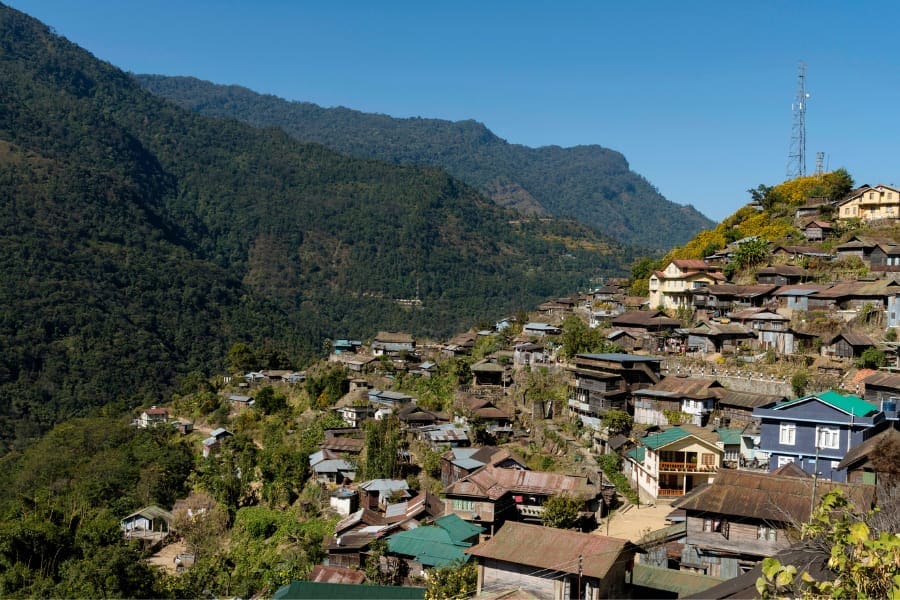
Considering how much the natives are involved in the development of the village, you can stay assured of a unique experience. Interacting with the villagers and indulging in their activities will help you understand their culture and traditions. In this regard, you might also want to note that Khonoma is the only Indian village known for its self-identity and the global citizenry at the same time.
Besides the rich indigenous culture here, Khonoma also stands out for its natural beauty. This village is also a great place to witness terrace farming in practice. The Khonoma Nature Conservation and Tragopan Sanctuary (KNCTS) is another key attraction for nature tourism.
5. Sundarbans, West Bengal
It comes as no surprise that Sundarbans, the largest mangrove forest in the world is a top destination for nature travel. Located on the coastal fringes of West Bengal, this forest offers a unique ecosystem rich in flora and fauna alike. The Sundarbans is a vast area with plenty of tourist attractions, including the Bhagabatpore Crocodile Project, Kalash beach, Lothian Island sanctuary, etc.
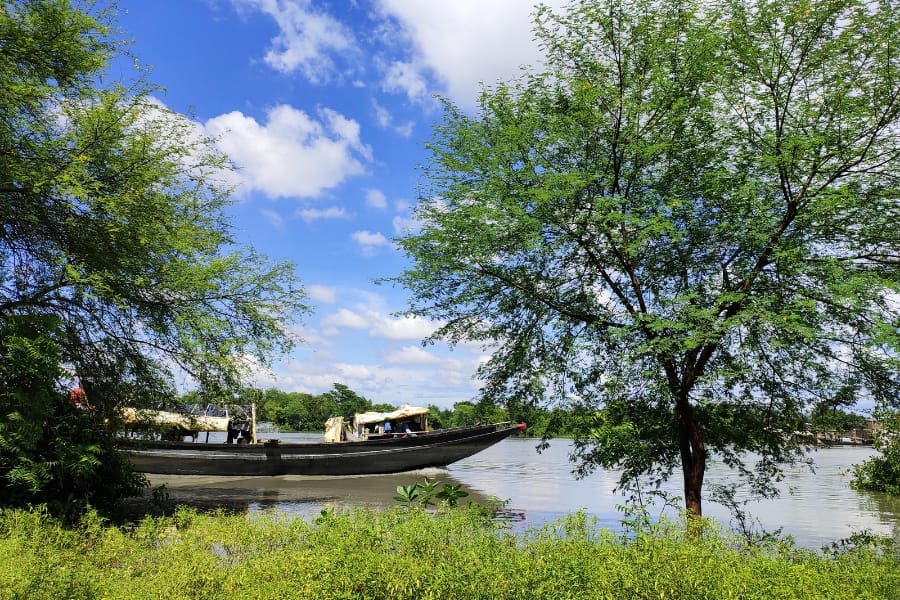
The Sundarbans Tiger Reserve spans 2585-sq-km and contains over a hundred Royal Bengal Tigers. In addition to them, this deltaic region is also home to water monitors, Gangetic dolphins, saltwater crocodiles, luminescent Kingfishers, and more. Besides wildlife, the vast expanses of greenery are a prime attraction too, with plenty of plant species.
UNESCO has recognized Sundarbans as a World Heritage Site, thanks to its biodiversity and indigenous culture. Various measures have been taken to promote responsible tourism in the Sundarbans, including infrastructural development and spreading awareness. Ecotourism has also helped the locals find alternative means of livelihood, thus reducing their dependence on forest resources. This is a perfect example of eco-tourism aiding in the conservation of nature.
If you like wildlife, also visit Jaldapara National Park in North Bengal. It is the second largest home of Asiatic one-horned rhinos after Assam’s Kaziranga National Park.
6. Mawlynnong Village, Meghalaya
Are you looking for an ecotourism destination that will help you enjoy a refreshing experience in a clean and green environment?
If so, you’d love Mawlynnong Village in Meghalaya, the cleanest village in Asia, as well as India. In fact, the village has completely banned the use of plastic and has eco-friendly waste collection measures to keep the streets clean of litter. This, coupled with the ample lush greenery and nearby living root bridges in Mawlynnong Village, helps create a healthy and reviving environment.

This village comes with beautiful cottages and homestays for accommodation. Mostly made of bamboo and wood, these buildings offer close proximity to nature. The bamboo machans in Mawlynnong Village will allow you to enjoy great views of the village and the surrounding plains, towards the India-Bangladesh border. While you stay in the village, you may explore the culture of the indigenous Khasi tribe that lives here.
Overall, Mawlynnong Village in Meghalaya is an amazing place to relax and enjoy the beauty of nature. For these reasons, Mawlynnong village is one of the best places to visit in Meghalaya. You may also visit Shiliang Jashar, another beautiful village located close by if you have time. Besides the lush green vegetation, the region also has beautiful waterfalls, crystal-clear streams, and an iconic bamboo bridge.
Apart from these places, there are also some other great Indian ecotourism destinations like Pawna Lake Camping in Maharashtra, Gujarat, Chota Mangwa Ecotourism Complex in West Bengal, etc. While visiting any of these locations, you should follow some eco-friendly practices.
Eco-Friendly Practices For Ecotourism
One of the key aspects of responsible tourism is following eco-friendly practices that help conserve the environment. If you are going on an ecotourism trip, you should be responsible for how you travel and aim to minimize your impact on nature. Here are a few eco-friendly practices that tourists should follow for ecotourism-
The local authorities in ecotourism destinations try hard to keep these places clean and green. In some places like Sikkim, the use of plastic bottles is banned entirely. However, even if you visit a place without such restrictions, avoid creating plastic waste during your travel.
During our travel all over India, we have noticed some unaware or not enough responsible tourists always dispose of different types of garbage. This includes Styrofoam plates and containers for picnics, empty food packets, and plastics amid Mother Nature. This is a bad practice and should never be done.
For example, check this photo with a stream flowing from a waterfall (behind) and descending the terrains. It looks beautiful, isn’t it?
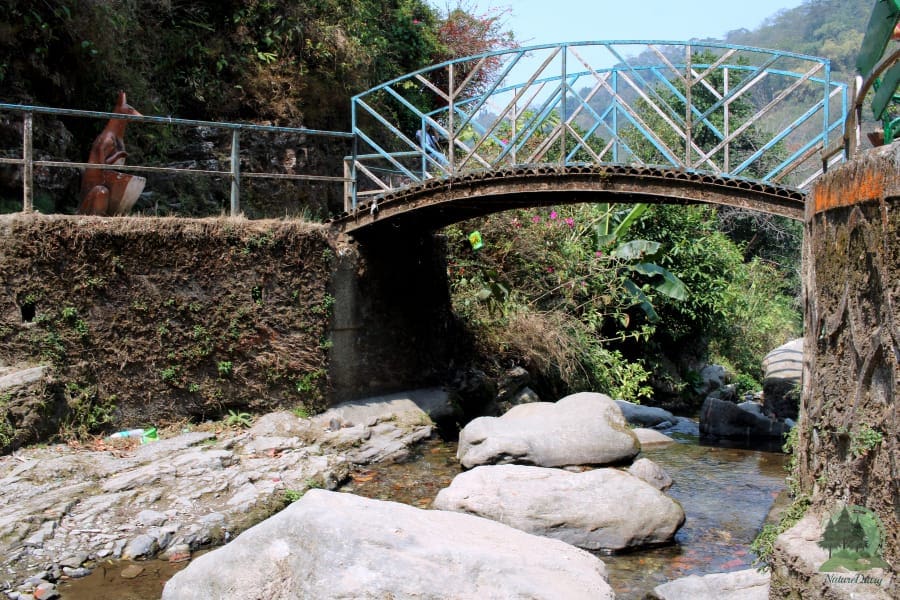
But, if you zoom the photo and look closely, you will find several chip packets and plastic water bottles lying around the stream. The irony is there is a dustbin just around the corner, which some tourists did not use.
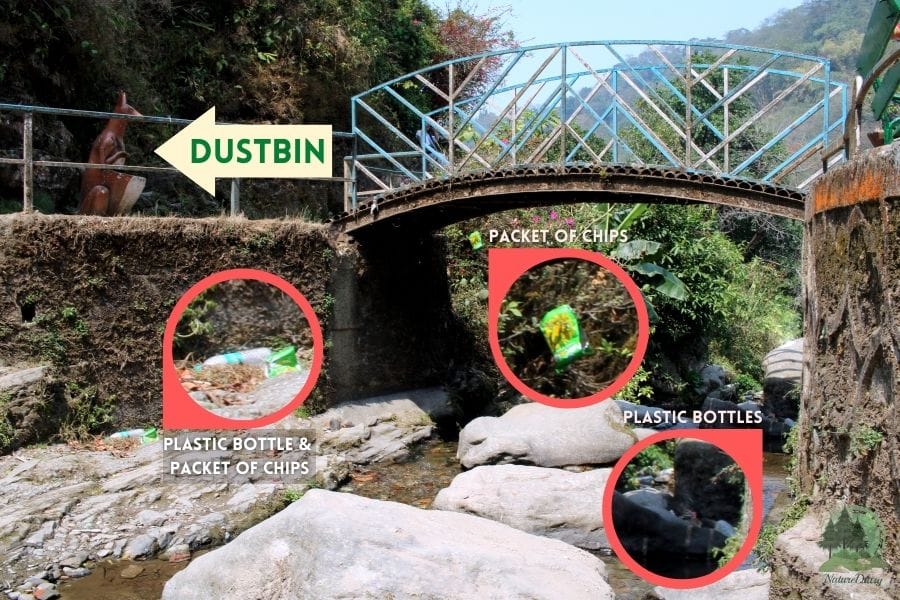
These plastic wastes are carried away to the river and ultimately pollute it. This is straining to the eyes, and deep inside, it slowly destroys the natural habitats and make them unsustainable for wildlife.
So, please be responsible and teach your children not to throw packets of potato chips, bottles of cold drinks, and chocolate wrappers here and there. Collecting these wastes in a bag and disposing of them in the nearest dustbin is an excellent eco-friendly practice.
Buying souvenirs during travels is a common practice among tourists. While there’s nothing wrong with it, and it’s a good idea to bring home something memorable or buy them as gift items, avoid purchasing wildlife products.
For example, various animals are killed for fur, while identical products made of faux fur are available in the market too. Handicrafts and other items that aren’t the result of animal cruelty make far better souvenirs.
If you rent a car, try to share one with other tourists unless you are travelling in a group and need a whole car for yourself. This will help cut carbon emissions greatly while helping you save money. Moreover, travelling together with other tourists can also help you meet amazing people and help you enjoy a great experience.
Rather than renting a car throughout the trip, travel on foot when you can. Alternatively, you can also choose to rent a bicycle if possible. This will help you reduce your carbon footprint and avoid polluting the environment.
After all, the whole point of ecotourism is to enjoy the beauty of unpolluted nature. Walking, hiking or trekking rather than taking a car will also enable you to explore the beauty of the place more closely and notice every detail.
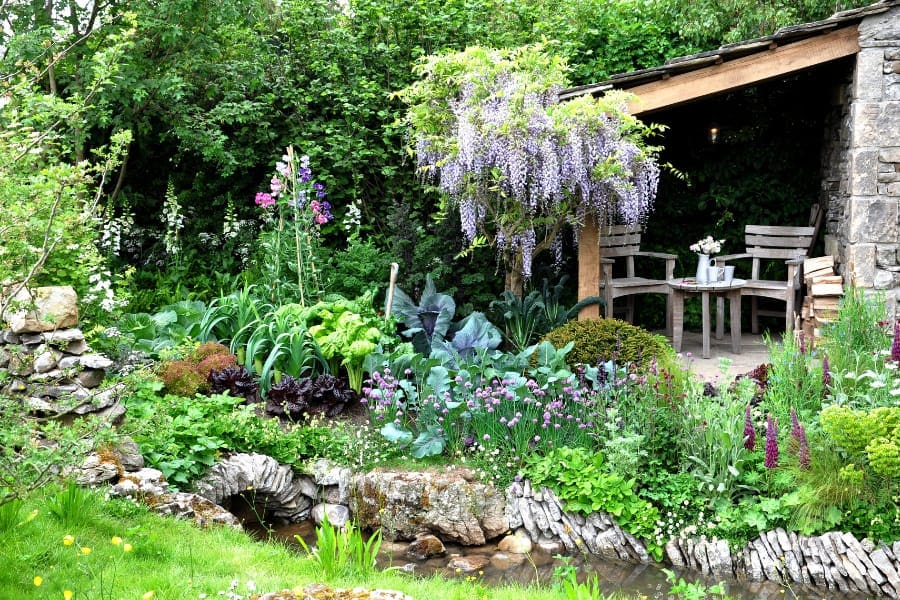
Embrace Ecotourism
If you have been wondering whether it is a good idea to go for eco-friendly nature travel rather than traditional tourism specifically, you must be aware that it is indeed. Ecotourism is important with several advantages and disadvantages that will help you enjoy experiences that you will remember for a lifetime. Additionally, considering the positive impacts of responsible tourism on the environment and the economy, you should embrace it.
While the six destinations listed above are among the best ecotourism destinations in India, there are many new places that are getting popular. Such locations are spread all over the country – all you have to do is research your options. If you aren’t sure about how to go about it, you can always seek the help of a tour operator that offers ecotourism services.